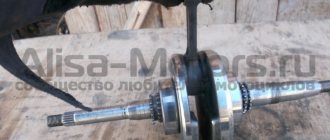It would seem, what could be simpler? I drained the old oil and filled in new oil, but no... There are people who manage to mess up here too.
I won’t go far for examples: I had the opportunity to repair several scooters whose oil filter was simply clogged with debris. As a result, the oil could not flow through it to the rubbing parts and the engine seized. To my fair question to the owner: why didn’t you clean the filter when you changed the oil??? A typical answer followed, which frankly killed me: “why clean it?” “What filter is there?” (???).
I sometimes get the impression that many scooter owners compete with each other to see who can destroy their vehicle the fastest. And then they complain on every corner that the “Chinese” are shit a priori.
So, the most common mistake made when changing engine oil is when, out of ignorance or on purpose, the oil filter is not cleaned.
Look, the owner of this scooter never cleaned the filter, and he changed the oil regularly: every 2000 km. As a result, the filter became clogged and the engine seized.
The second most common mistake I have encountered is when the oil is drained not through the drain plug, but through the filter plug. By and large, this is not critical, but if you drain the oil through the plug, the oil does not completely drain from the engine, and when you fill it with fresh oil, it will mix with the old one, which will greatly worsen its performance.
When changing the oil in the gearbox, the situation is no better. Many owners do not even suspect that the scooter has a gearbox and the oil in it needs to be changed as often as in the engine. That is, every 2000 km.
Sometimes you open the gearbox of some old scooter, and instead of oil there is some kind of slurry there. What can I say - it’s slurry. They poured oil there at the factory, but no one has changed it yet.
I recently disassembled the gearbox of an old Honda and instead of oil there was a slurry that looked very much like dung... The bearings were naturally “taken away”, it’s good that I looked there in time, otherwise the rear wheel along with the axle in front of the scooter would have rolled, and the owner would have rolled into a ditch...
Look at the fluid in this gearbox... I wouldn’t be surprised if it’s still the original factory oil...
Actually, the oil change itself, both in the engine and in the gearbox, consists of two main stages: preparatory and, strictly speaking, the replacement itself.
How to change the oil in a scooter gearbox yourself?
The first step is to select transmission oil for the scooter. In general, this is quite easy to do, you just need to follow the manufacturer's recommendations. You can also use motor oil with a viscosity of 10W-30
, especially if your scooter does not sit idle during the cold season, this composition will be more liquid, which means you have a reserve of viscosity for cold weather.
In addition, ATF
, characterized by excellent fluidity and excellent protective properties.
Having selected the desired fluid, you can proceed directly to replacing it. This can only be done on well-warmed-up equipment, so you can ride it first or simply warm up the gearbox for twenty minutes. This way, the old oil will become thinner and easier to drain, and all the dirt and debris that has settled at the bottom will rise and come out along with the liquid.
Next, having previously wiped the drain and filler holes, unscrew the nuts from them (first from the filler hole, then from the drain hole). Then, replacing the container, remove the old oil. At this time, you can wash all the removed bolts and nuts in gasoline. When there is no drain bolt, the oil is changed using only one bolt; in this case, the scooter should be tilted on its side. It is better to fill in new liquid using a medical syringe, drawing the required amount into it. Most often, the required volume is stamped on the gearbox housing, but if there are no such instructions, then you can fill it to the bottom of the bolt thread.
The first time you should change the oil after 500 km, then every 1000. It is also recommended to change the oil after carrying out work on the cylinder: replacing the cylinder, removing the cylinder head, etc., since during these works, even if everything was done carefully, there is a possibility dirt and metal particles getting into the engine. You will need a wrench with a head (most likely 19).
The oil change must be carried out when the engine is warm - this way the oil becomes more fluid, and dirt, if any, rises from the bottom of the crankcase, mixing with the oil. The scooter must be placed on the center stand.
Work order:
- Unscrew the filler cap (dipstick), located on the right side of the engine, next to the generator
- Place a container (about 1 liter) under the drain hole to drain the used oil and unscrew the drain plug counterclockwise. To unscrew, use only the head - an open-end wrench can damage the drain plug, which is made of aluminum. Under the plug there is a spring and an oil filter - mesh
- Drain the oil
- Wash the drain plug and filter in gasoline
- Screw in and tighten the drain plug. Don't overdo it - remember that the plug and crankcase are made of aluminum. Excessive force may damage the threads.
- Pour 800 ml of engine oil into the engine through the filler neck using a suitable funnel.
- Tighten the filler cap
Preparation
To ensure that all the used oil leaves the engine without any residue, the engine should be thoroughly warmed up before changing the oil. Or, what would be best, start changing the oil immediately after a 5-10 km trip.
The second preparatory stage is that we need to prepare in advance a flat area on which to install the scooter in the most level position possible and prepare a suitable container for used oil.
The tools you use also play an important role. Don't skimp - buy a new head with a knob. You will only need two of them: for 17 and 10. Those who neglect this point pay dearly later, and out of their own pocket.
Why should you mix gasoline and oil?
Not everyone knows how to dilute gasoline for a two-stroke Chinese scooter, and why there is a need to mix gasoline and oil in strictly defined proportions. The fact is that the design features and operating principle of a two-stroke engine do not allow the use of pure gasoline for its operation. Thanks to the oil introduced into the fuel mixture, lubrication is provided and friction in the crank mechanism is reduced.
Mixing oil with gasoline when preparing the fuel mixture is a prerequisite for the normal operation of two-stroke engines.
Diluting gasoline with oil allows you to:
- increase the service life of the power plant;
- ensure effective lubrication of rubbing parts;
- avoid jamming of engine parts due to overheating;
- prevent possible damage during engine operation.
In addition, the use of gasoline mixed with oil in the required percentage allows you to avoid the occurrence of scuffing, which is the reason for repairs. A lack of oil can cause overheating of the elements of the cylinder-piston group and failure of the two-stroke engine.
An increased oil concentration will cause increased wear on the engine due to the formation of a thick layer of carbon deposits. That is why it is important to determine the proportion using the table, which indicates the required amount of oil for different volumes of gasoline.
The reason for the formation of carbon deposits in the working chamber is the use of low-quality oil.
Scooter with four stroke engine
For scooters with a regular gearbox, 4t oil is suitable, but if your scooter has a CVT gearbox, then you need gear oil. In the case of a 4t scooter, the choice of oil comes down to the same principle as for a 2t. That is, it all depends on the riding style, the technical condition of the moped and also its age. If we talk about four-stroke mopeds, then it is recommended to fill them with 10w-40 oil. In principle, a moped can run on regular car oil, but use such oil at your own peril and risk. The oil must protect all rubbing parts well, and there are a large number of them in the engine. And the scooter clutch especially needs high-quality oil, since it literally floats in oil.
If we are talking about what kind of oil to pour into cubic capacity motorcycles, then two-stroke synthetic is better. This way the cylinder-piston group will remain clean and well preserved. This oil is the most resistant to various temperatures. Also, synthetic scooter oil produces less soot, which settles in the muffler and clogs it.
Why change the oil
I met a person who did not change the oil for 3 seasons. His ATV was being repaired and there was little left of the oil, everything was covered in soot. And the engine was working in this one, it’s good that it was still working at all. But it significantly reduced its service life, and the repairs cost a pretty penny.
As mentioned, a good synthetic oil prevents the formation of carbon deposits and is resistant to temperatures. Carbon deposits interfere with engine operation and reduce its service life, complicate the life of compression rings and cause overheating. And given that the amount of carbon deposits is constantly increasing, plus constant overheating, repairs will not take long. And expensive motorcycles require expensive repairs. Therefore, it is not recommended to skimp on oil.
The first time you should change the oil after 500 km, then every 1000. It is also recommended to change the oil after carrying out work on the cylinder: replacing the cylinder, removing the cylinder head, etc., since during these works, even if everything was done carefully, there is a possibility dirt and metal particles getting into the engine. You will need a wrench with a head (most likely 19).
The oil change must be carried out when the engine is warm - this way the oil becomes more fluid, and dirt, if any, rises from the bottom of the crankcase, mixing with the oil. The scooter must be placed on the center stand.
Work order:
- Unscrew the filler cap (dipstick), located on the right side of the engine, next to the generator
- Place a container (about 1 liter) under the drain hole to drain the used oil and unscrew the drain plug counterclockwise. To unscrew, use only the head - an open-end wrench can damage the drain plug, which is made of aluminum. Under the plug there is a spring and an oil filter - mesh
- Drain the oil
- Wash the drain plug and filter in gasoline
- Screw in and tighten the drain plug. Don't overdo it - remember that the plug and crankcase are made of aluminum. Excessive force may damage the threads.
- Pour 800 ml of engine oil into the engine through the filler neck using a suitable funnel.
- Tighten the filler cap
Gearbox design in the T4 scooter
The gearbox consists of a set of gears, which are located in a common housing - in the crankcase. Thanks to the presence of the crankcase, all parts are located compactly. The crankcase protects all elements from mechanical damage and contamination, providing good lubrication of gearbox parts.
A gearbox is necessary to adjust the speed of rotation of the shafts down or up. On a scooter, this element is located between the secondary clutch shaft and the wheel.
The gearbox is divided into primary and secondary gears:
- The primary gear is the first and second gears.
- The secondary gear includes the third and fourth gears.
Both gears always consist of two gears - one large and the other small.
There is a hole in the gearbox housing for draining and filling fluid. The filler plug is just a regular bolt and washer. Transmission oil is poured into the scooter. It is advisable to check the fluid level in the crankcase once a month.
If the oil level has dropped or is completely absent, the gearbox begins to make an extraneous noise. Extraneous noise is produced by worn gears with a small amount of lubricant. And this will lead to wear of gears, bearings and bushings.
Draining the oil and flushing the gearbox
So, having selected the right lubricant for the regulator, you can begin to drain the old oil. Changing the scooter oil in the gearbox is carried out when the scooter is warmed up. To do this, it is enough to ride a scooter for 20 minutes before the change process. The heated liquid becomes more liquid, and this will help quickly drain the waste along with dirt or metal debris.
Draining the oil and flushing the gearbox:
- Wipe the drain and filler (bolt) holes with a clean rag.
- The filler hole is located at the rear of the power unit.
- Unscrew the nuts from the filler bolt, and then from the drain hole.
- Substituting an empty container, drain the old liquid.
- While the old oil is draining, wash the removed nuts and bolts in gasoline.
If metal particles are found when draining the old oil, the regulator housing should be flushed. To do this, remove any remaining lubricant from the crankcase and fill in transmission oil to flush it. The viscosity of the flushing fluid should be higher.
To flush the gearbox housing, you must:
- Tighten the drain bolt and then the filler hole.
- Start the power unit and rev it up a little.
- Drain the washing mixture.
- Tighten the drain hole.
This completes the process of draining the old fluid from the scooter gearbox. Changing the oil in the gearbox of a 4t 50q scooter is completed by filling in new fluid.
Filling with new oil
After draining the old lubricant and flushing the gearbox system, all that remains is to fill the transmission oil. Moped manufacturers recommend using the following modifications 75W90, SAE 80W90, 85W90 with API quality class: GL-4; GL-5.
The required volume of lubricant is always indicated on the gearbox. Use a large syringe to take the required amount of oil and pour it into the filler hole.
If you don’t have a syringe, you can simply fill the liquid to the lower level of the filler hole. The vehicle must be in an upright position when filling the oil. After pouring oil into the T4 scooter gearbox, wipe the filler bolt and plug dry. Carefully tighten the filler bolt and check the tightness of the connections.
In conclusion, I would like to note that the long-term performance of the scooter gearbox depends on regular maintenance such as timely replacement of transmission fluid.
Table oil gasoline - choose the correct proportion
Beginning motorcycle owners do not always have an idea how much oil to add to gasoline. Depending on the manufacturer's recommendations specified in the instructions, the volume of added lubricant may vary. The most common ratios are 1:50 and also 1:40. Minor deviations from the specified proportions will not affect the operation of the two-stroke engine.
During the break-in period, when intensive grinding of the mating parts of the engine occurs, the amount of oil increases slightly. When the break-in is completed, switch to a different fuel mixture ratio, which involves introducing a smaller amount of oil.
It's not difficult to figure out the proportions. For example, a ratio of 1:50 means that a liter of lubricant should be added to 50 liters of gasoline. Using measuring containers will greatly facilitate the process of preparing the mixture. Depending on the volume of the available container, the amount of added oil changes.
You can quickly prepare the mixture by deciding on the proportions
In particular, for a proportion of 1:50, the table will help determine the volume of oil introduced:
- to dilute 5 liters of gasoline you will need 100 ml of lubricant;
- You will need to pour 200 ml of oil into a ten-liter container;
- 400 ml of lubricant should be added to a 20-liter canister.
Having decided on the proportions, you can quickly prepare the mixture. However, you should not use the gas tank for this, alternately filling in gasoline and oil. Mixing must be done in a separate container.
Gearbox oil change timing
That is why, for reliable operation of the scooter as a whole, it is necessary to observe the timing of fluid replacement. In most cases, the frequency of oil changes and the recommended lubricant class are indicated in the manufacturer's instructions. If there is no information about the timing of the change, the oil in the scooter gearbox is changed every three to five thousand kilometers or once a year.
A sufficient oil level in the gearbox reduces shock loads, vibrations and extraneous noise. Due to the enormous loads on a Chinese scooter, constant care of the vehicle is required. After a certain time or mileage, the oil loses its quality, becoming saturated with metal elements and forming sediment. And this will lead to a deterioration in the lubricating properties of the fluid, without providing reliable protection. Without sufficient fluid in the gearbox, this part may quickly break down.
When purchasing a new vehicle, changing the oil in the gearbox on a scooter is done more often. The first fluid change on a new scooter is carried out after 300 km, and the second time after 1000 km. But the quality and reliability of driving a moped also depends on the required oil level in the gearbox. In order for the level to comply with the standards, it is necessary to check it every 2.5 thousand kilometers and, if necessary, top up the fluid.
Considering the timing of fluid changes, we must not forget about the correct choice of oil. When purchasing lubricant, you should always take into account the recommendations of the scooter manufacturer. The gearbox can be filled with Motul Scooter Gear transmission oil, although its volume is only 150 ml; liquid with viscosity 80W-90 or 75W-90. It is allowed to fill the gearbox with motor oil with a viscosity of 10W-30. The most acceptable fluid option for a scooter is ATF gear oil, which has good fluidity and excellent protection properties.
Necessity
During use of the scooter, metal dust accumulates in the oil, resulting from the wear and tear of engine parts. It changes the structure of the oil and worsens its properties. Low-quality motor oil is often found, characterized by sedimentation. In addition, over time, the consistency of the oil fluid changes, and other defects appear that have a detrimental effect on the scooter engine. The uninterrupted operation life of the machine is significantly reduced. Saving on oil will inevitably lead to expensive repairs.
Scooter oil - 2t, 4t, types of oils
One of the essential attributes of any vehicle is oil, because it allows your engine to operate properly and smoothly. A scooter also needs quality oil and so we will look at the process of choosing this product.
As you probably already know, according to the type of engine, a scooter is divided into 2-stroke and 4-stroke, so for this purpose different types of oil have been created that meet the requirements of the engine. You can buy scooter oil for your engine in any store; the choice of oils is so wide that you will only have to decide on the price. But it is also worth knowing that there are also two types of oils - synthetic and mineral. But we will start with choosing oil according to engine type.
Oil for 4t engine
When choosing oil, first of all pay attention to the price. If you want your scooter to work smoothly and the engine not to overheat, buy expensive oil from a branded manufacturer
Expensive oil has already proven itself in the market, and therefore most scooter riders use it. To select the right oil, read the owner's manual for your scooter model, which will indicate the scooter's viscosity rating. But if you do not have such a manual, we will recommend standard indicators for 4t scooters.
As a standard, such scooters should be equipped with motor oil with a viscosity of 15W40 and 10W40. For them, there is a separate temperature regime and level of wear of your engine. In case of significant wear on your engine, use oil with a viscosity of SAE 20W-50.
Oil for 2t engine
Engines with two-stroke systems have a slightly different approach to choosing oil, and here the quality of the product plays an important role rather than viscosity. As you should know, all Japanese small-capacity scooters with a 2T engine have a separate oil tank, from which the oil goes to the oil pump, and then to the fuel mixture. That is why such motors require a special lubrication system. Since such a motor goes through a full circle in 2 strokes, at this time the resulting oil should not only burn together with the fuel, but also create a small but high-quality film. High-quality oil should not leave residue, mixing and dissolving in full.
Types of motor oil
Also, motor oil for scooters is made into three types - synthetic, semi-synthetic and mineral. Let us immediately note that synthetic oil is the highest quality and most productive; it burns faster without leaving a negative residue. This type will always be a leader, because the manufacturer tries to follow innovations and modernize the composition of the oil. Mineral motor oils are considered the cheapest and lowest quality, so we strongly do not recommend using them. The use of a mineral product has a negative effect on the engine - it causes a lot of carbon deposits, the scooter loses power or has trouble starting. The worst result is a breakdown of the piston group, which overheats and jams due to lack of oil.
In conclusion, here are some of the highest quality and most popular types of motor oil for scooters (2t and 4t)
Manufacturers of motor oils:
- Motul
- Castrol
- IPone
- Liquid moly
- Mannol
- ZIC
- Lukoil
avtomoto-best.ru
Top 8. Mannol 4-Takt Plus
Rating (2021): 4.16
22 reviews taken into account from resources: Yandex.Market, Otzovik
Universal purpose Oil with a wide range of approvals. Suitable for both small scooters and powerful motorcycles, as well as special equipment using four-stroke engines.
- Characteristics
Price per liter: 430 rub.
- Country: Germany
- Type: semi-synthetic
- Viscosity: 10W-40
It doesn’t matter what kind of scooter you have, whether its engine has 50 cc or more than 150 – this oil can be poured anywhere. Even into a chainsaw or generator. The main thing is that the engine is four-stroke. Many experts argue that such versatility is unacceptable, but judging by the reviews, the oil is of quite high quality. In addition, the brand has long established itself in the market and is famous as a manufacturer of high-quality lubricants at attractive prices. Unfortunately, we do not know what technologies the company uses in production. You can only rely on user comments, and they are mostly positive and even laudatory. Oil can also be used as a topping, which is also a plus.
Advantages and disadvantages
- Wide range of applications
- A brand with an impeccable reputation
- Little information about components and additives
- Virtually no protection against copying and counterfeiting
Changing engine oil
Draining used oil
We place the scooter on the center stand; if it is crooked, we straighten it. On the left side in the direction of travel of the scooter, at the very bottom of the engine, look for the drain plug, place a previously prepared container under the plug and unscrew the drain plug with a 17mm head.
While the oil is draining, go to the right side of the scooter and unscrew the dipstick and the oil filter plug, which is located at the very bottom of the engine.
We put a good 17 socket on the plug, unscrew it and remove it with all its contents from the engine.
This is the oil filter. Immediately after unscrewing it, while the point is still important - throw all this junk into clean gasoline, give it a good shake, and then blow it out and dry it.
After the oil filter plug is removed from the engine. In order to remove any remaining oil from the engine, pump the engine several times using the kickstarter.
Then we wait about five minutes - wipe the drain holes dry, for greater reliability, apply sealant to the plugs and screw them into place.
Filling the engine with new oil and checking its level
Depending on the design of the canister, pour oil into the neck either directly from the canister itself or through a funnel. The funnel must be clean!
Oil level control
The oil level is checked as follows: pour the first portion of oil into the engine, approximately 600-700 ml, wait a couple of minutes until the oil spreads evenly over the crankcase without twisting, insert the dipstick all the way into the filler neck, remove it and check the level.
The oil level must be within the control area.
- If the level is lower, add a little oil, wait a couple of minutes and take a measurement.
- If the oil level is higher than normal, drain it or, better yet, pump it out using a syringe with a tube from the neck.
The control area is indicated by red arrows. In my case, the oil level is exactly in the middle of the control section and is indicated by a blue arrow. Ideally, the oil level should be near the upper boundary of the control section. But this is ideal, but in practice, the average level is quite acceptable and does not in any way affect the reliability and durability of the engine.
What oil to dilute gasoline for a motorcycle
Two-stroke engines do not provide for separate filling of lubricant into the engine crankcase.
Strict requirements are imposed on the oil that burns together with the fuel:
- the lubricating fluid must provide effective lubrication of all parts;
- The oil should burn easily and not form carbon deposits after burning.
The use of low-quality oil for two-stroke engines causes the formation of carbon deposits in the working chamber and a decrease in power.
When deciding on the type of oil, you should follow the recommendations of the equipment manufacturer specified in the operating manual. Preference should be given to branded oils produced by well-known manufacturers. The preferred oil class is API-TB. It is also possible to use oil marked API-TC.
The type of lubricant is selected depending on climatic conditions:
- in the warm season, gasoline can be diluted with mineral oil;
- in the winter months you should give preference to synthetic oils;
- For all-season use, branded semi-synthetics are suitable.
When deciding on the type of oil, you should follow the recommendations of the equipment manufacturer.
To obtain detailed information about the temperature threshold for use, you should read the information on the oil packaging. Knowing the ratio of fuel and oil required for stable engine operation, as well as the volume of the gas tank, you can easily calculate how much oil is required for a certain period, taking into account the frequency of trips or use of gas-powered tools.
When buying oil for preparing the fuel mixture, you should pay attention to its purpose. This information is indicated on the packaging. Do not use tractor oil or boat lubricant to mix with gasoline to fuel a scooter or motorcycle. Please note that on the branded label of oil for two-stroke engines it must be designated 2T.
Scooter with four stroke engine
For scooters with a regular gearbox, 4t oil is suitable, but if your scooter has a CVT gearbox, then you need gear oil. In the case of a 4t scooter, the choice of oil comes down to the same principle as for a 2t. That is, it all depends on the riding style, the technical condition of the moped and also its age. If we talk about four-stroke mopeds, then it is recommended to fill them with 10w-40 oil. In principle, a moped can run on regular car oil, but use such oil at your own peril and risk. The oil must protect all rubbing parts well, and there are a large number of them in the engine. And the scooter clutch especially needs high-quality oil, since it literally floats in oil.
If we are talking about what kind of oil to pour into cubic capacity motorcycles, then two-stroke synthetic is better. This way the cylinder-piston group will remain clean and well preserved. This oil is the most resistant to various temperatures. Also, synthetic scooter oil produces less soot, which settles in the muffler and clogs it.
Why change the oil
I met a person who did not change the oil for 3 seasons. His ATV was being repaired and there was little left of the oil, everything was covered in soot. And the engine was working in this one, it’s good that it was still working at all. But it significantly reduced its service life, and the repairs cost a pretty penny.
As mentioned, a good synthetic oil prevents the formation of carbon deposits and is resistant to temperatures. Carbon deposits interfere with engine operation and reduce its service life, complicate the life of compression rings and cause overheating. And given that the amount of carbon deposits is constantly increasing, plus constant overheating, repairs will not take long. And expensive motorcycles require expensive repairs. Therefore, it is not recommended to skimp on oil.
And what will happen if you don’t change the oil, you will find out from the video:
How much oil to put in a scooter
Each scooter needs a different amount of oil. But using the golden rule this can be easily understood. After all the oil has been drained from the crankcase, you need to measure how much of it came out and then fill in the same amount plus 3-5 percent. If the scooter is new, then you don’t have to add 3-5%, and fill in as much as you drain.
Scooter with two-stroke engine
If the scooter engine is two-stroke, then the oil for it must be 2 tons. This type of scooter eats oil and is added in small doses to gasoline (in modern 2T scooters, oil is no longer diluted with gasoline thanks to a separate engine lubrication system). Therefore, the oil must be such that it mixes well with gasoline and does not settle at the bottom and clog the carburetor. 2t oil copes well with this.
What kind of oil to pour into a 2T scooter depends on your riding style. If you drive slowly around the city or on the highway, then semi-synthetic and mineral oil are suitable for you. But if you have severe frosts and bad weather conditions, or you are always moving at full throttle, then you need synthetic oil. It does not change its properties down to -35C. Of course, under such conditions it is not recommended to ride a scooter; in this case, a car would be more suitable. It is recommended to fill a scooter with a two-stroke engine with oil from the following manufacturers:
- Motul
- Mol Dynamic
- Castrol Power
- Castrol Act Evo
- Repsol Moto (Sintetico 2t, Off Road 2t, Racing 2t, Competicion 2T)
- And other quality oils.
And even if you have an old twenty-year-old scooter, do not neglect quality oil. It doesn’t matter whether the scooter is new or old, everyone is required to ride it.
How much lubrication is required
- Any scooter owner needs to understand what kind of oil is recommended to use in their small-displacement engine and exactly how much oil should be filled in for the engine to operate efficiently in any weather. The average is 1-2 liters, but a lot depends on the specific type of scooter and its brand. For a more accurate understanding, the owner should read a book on servicing his scooter or select a model on the website and read the instructions.
- In a situation where the document cannot be found, it is better to take the advice of repairmen.
- The amount of liquid itself that you fill during replacement is on average about 1-2 liters. Experienced specialists or owners of small motorcycles will tell you a more accurate parameter. But at the beginning of use it is recommended to fill in about 1.5 liters.
Top 3. Eni/Agip i-Ride Scooter
Rating (2021): 4.77
71 reviews taken into account from resources: Yandex.Market, Ozone, Otzovik
The most popular oil Lubricant from a famous brand, which has surpassed all competitors in terms of the number of reviews. The product is often found in test reviews and is recommended by professional mechanics.
- Characteristics
Price per liter: 470 rub.
- Country: Italy
- Type: semi-synthetic
- Viscosity: 10W-40
If you've ever had your scooter repaired by a mechanic, you've probably heard of this brand. It is this that is most often recommended to be poured into 4-stroke engines, and it does not matter whether you have 150 cubic meters or just 50. In addition, the name can be found in the technical documentation of many scooters and motorcycles. At least those brands that do not produce their own lubricants. The lubricant is especially recommended for owners of sports equipment subjected to heavy loads. Accordingly, an ordinary city scooter will feel just great with it. As experts from the Drive portal say, loading Agip i-Ride means loving your bike and wishing it many years to come.
Advantages and disadvantages
- Recommended for heavy loads
- Often mentioned by professional mechanics
- Strictly controlled quality
- Weak protection against counterfeiting
- Do not pour on top of another lubricant
See also:
- 20 best motor oils
Why is fresh scooter gear oil necessary?
One of the most important components of a scooter can rightly be called the gearbox. It is responsible for timely reducing the speed of the driven shaft, thereby increasing torque. That is, it converts high shaft and clutch speeds into fairly powerful, but low wheel speeds. This part consists of a number of rubbing elements (gears and bearings) that undergo enormous loads, and, as expected, they need good care. It is the transmission oil that provides such care.
It is an oil doped with various functional additives. The main function of transmission fluids can be called protective, as they protect the surface from wear, corrosion, seizing, etc. In addition, thanks to them, energy losses are reduced and heat removal from friction surfaces is ensured. Shock loads, vibrations and noise in gear drives are also significantly reduced.
Changing the engine oil
In 2-stroke technology, the oil does not change, but is regularly poured into a separate tank and supplied by an oil pump to the carburetor, where it is mixed with the air-gasoline mixture and supplied to the engine.
The mixture lubricates the rotating and rubbing parts of the engine, burns and exits with exhaust gases into the exhaust pipe.
Oil tanks on scooters have different volumes - from 0.6 l to 1.3 l.
If you ride a motorcycle every day, then five liters of oil will be enough for a 2-stroke engine for the summer season.
The Oil lamp on the instrument panel indicates that the oil has dropped to the reserve level.
If the lamp lights up, it means that there is little oil left in the tank.
We'll have to capitalize on it. And this, you understand, is time-consuming and expensive repairs.
On 4-stroke 50 cc motorcycles, the oil is changed every 2 - 3 thousand km. During this mileage, fuel combustion substances accumulate in the oil and, as a result, it becomes dirty and thick, which changes its structure and properties.
If you drive together, transport cargo, that is, when the engine often works under heavy loads, then change the oil more often, after 1 - 1.5 thousand km.
Let's get down to business.
Start the scooter for 5 - 10 minutes. until the increased speed drops.
Place the motorcycle on the stand and turn off the engine.
Loosen the drain bolt.
Place a liter jar to drain the waste and unscrew the bolt completely.
Then unscrew the oil dipstick.
In 5 minutes, all the oil will flow out of the engine.
On a Honda Dio 56, there is a filter mesh under the oil drain cover. Wipe it well with a dry cloth and blow it or rinse it in gasoline.
On a Honda Dio 68, the oil filter mesh is located near the variator. The mesh also needs to be removed and washed.
Then reassemble everything in reverse order.
Fill the engine with oil through the dipstick. Its quantity depends on the motorcycle model and is indicated on the oil dipstick.
The level should be up to the top mark of the dipstick.
Screw in the dipstick.
As you can see, the procedure is not complicated, but it requires care and will take 20–30 minutes. It's always difficult to start the first time, but then it will be business as usual for you.
Recommendations for proper use of scooters
Scooters are fueled with AI-92 gasoline . It is not allowed to fill scooters with AI-98 gasoline, this will lead to overheating and burnout of the piston. As a last resort, you can fill it with AI-95 gasoline.
We also advise you not to refuel your scooter at unknown gas stations. This can result in low-quality gasoline and dirt entering the scooter’s fuel system, and premature clogging of the fuel filter and the entire fuel system.
The engine of a 2-stroke or 4-stroke scooter is very picky about the quality of oil. To the point that using low-quality oil can cause fatal damage to the engine in 1 day.
Motor oils that have proven themselves to be the best:
For 2-stroke engines:
Motul Scooter Expert 2T; Castrol Act Evo Xtra 2T; Liqui Moly scooter 2T.
For 4-stroke engines:
Motul Scooter Expert 4T; Liqui Moly scooter 4T.
In scooters with 2-stroke engines, oil is poured into a separate oil tank. During operation, in the engine, oil is mixed with gasoline automatically and is gradually consumed. One liter of oil for 2-stroke engines is usually enough for 600 - 800 km. for 50 cc engines, and for 500 - 600 km. for 90 - 125 cc engines, depending on driving style (the higher the speed, the higher the oil and gasoline consumption).
When the oil level in the oil tank drops to approximately 150 g. The warning light on the dashboard starts blinking (especially on rough roads). It is usually indicated by the inscription OIL or an oil can icon. If the oil level light in the oil tank is constantly on, you should immediately turn off the engine and fill the oil tank with oil.
Operating the scooter with the oil level light constantly on will lead to serious engine damage.
For standard scooters, it makes sense to fill only semi-synthetic oil. Cheap mineral oil, commonly used for lawn mowers, chainsaws and other garden equipment, should not be used at all. And it makes sense to use synthetic oil only on highly accelerated sports engines.
In 4-stroke scooter engines, oil is not consumed, but is located in the crankcase, and must be replaced (as in a car) after 3000 - 5000 km. mileage
The oil in the gearbox is changed once every one or two seasons. It is best to fill only synthetic oil for scooter transmissions. For example, Motul Gear Competition W75/140. For replacement you need about 100 ml. oil (more precisely, it is written on the gearbox cover of your scooter). You must fill in the exact volume indicated, using a syringe with a measuring scale.
air filter is usually a simple foam element. This is a very important part, which, if not promptly cleaned or replaced, usually quickly leads to serious engine damage. The frequency of cleaning or replacing the engine air filter depends on operating conditions. If you often drive on dusty roads (when dust swirls and flies behind you), then cleaning is required up to 1 time per week. If you drive mainly in the city on asphalt, then once every 2 - 3 months.
The scooter has a peculiar handling , which takes some time to get used to. Therefore, we advise you not to let unverified, inexperienced drivers and strangers “ride” the scooter. According to statistics, 90% of such cases end in a fall with injuries, or the scooter is broken or it can simply be stolen. You can only give a scooter a ride to those people whose driving skills you have no doubt about. If a person has ridden a motorcycle, this does not mean that he knows how to ride a scooter.
The scooter is quite simple in design, but, nevertheless, its repair requires special skills. Therefore, if you need to repair a scooter, it is better to contact a specialized service center or a trusted private technician.
Our company also deals with warranty and post-warranty repairs and maintenance of scooters.
Tel. service: +7 (915) 218-0820.
Choosing scooter oil
When purchasing an oil fluid, you need to focus on the viscosity recommended by the manufacturer, taking into account the temperature indicators of the region of use (seasonality). Lubricant mixtures for scooters are usually systematized according to the type of engine for which they are intended to operate.
The limitations are caused by the fundamental difference in the lubrication systems of two- and four-stroke engines. Therefore, when choosing oil for a moped, you must strictly follow the operating instructions and focus on the individual characteristics of the existing model.
Two stroke engine
Two-stroke engines installed on scooters are lubricated with oil fluids, which are first mixed with fuel and then burned in the cylinders along with it. Hence the specific requirements for this group of oils:
- good solubility in gasoline;
- low ability to form carbon deposits on the rings and internal surfaces of the muffler;
- protection of engine parts from wear and corrosion;
- low ash content;
- low smokiness of exhaust gases.
Special brands of oils for two-stroke engines:
- Eni i-Ride Scooter 2T is a semi-synthetic lubricant that guarantees high-quality engine operation even at high ambient temperatures. The oil has good cleaning properties, anti-wear characteristics, low ash content and low CO content in exhaust gases.
- Racing Scooter Synth 2T is a synthetic oil fluid with low smoke, good wear resistance and high lubricity. Prevents the appearance of alkaline and acid deposits on the internal surfaces of the cylinder block. Used for separate and mixed lubrication of two-stroke motorcycle engines.
Widget from SocialMart
- Racing Scooter 2T Basic is a mineral oil for low-power engines. It cleanses the system well of combustion and wear products. Has optimal lubricity. Can be used for both air- and water-cooled motors.
Scooter with four-stroke engine
Oil for scooters with a four-stroke engine is designed to work in difficult operating conditions. This is due to complex city traffic, where there are frequent stops, alternating driving modes, sudden acceleration, etc.
The specificity of engine lubrication is that some parts are lubricated under pressure using an oil pump - these are the main bearings, the crankshaft and the cylinder head. The remaining rubbing surfaces are washed by spraying or oil mist.
Operational requirements:
- high thermal properties;
- low viscosity at low temperatures;
- low ability to form varnish deposits and soot;
- antioxidant qualities;
- protection of parts from corrosion;
- stable cleaning properties.
Recommendations:
- MOTUL Scooter Power 4T is a synthetic oil for powerful scooters with four-stroke engines. The lubricating fluid works well in urban conditions, reduces the friction force in the contact areas of the parts, and ensures stable operation of the clutch mechanism immersed in the engine crankcase. It has good antioxidant, anti-corrosion and dispersing characteristics.
- LIQUI MOLY Racing Scooter 4T is a mineral oil fluid for four-stroke engines. Provides high-quality lubrication of engine rubbing surfaces. It has high anti-corrosion, thermal and anti-wear properties.
- ENI I-RIDE SCOOTER 4T is a semi-synthetic oil with high performance characteristics. The technical fluid has no temperature restrictions and guarantees reliable wear protection even in the most extreme conditions. Synthetic additives present in the mixture provide good non-stick and washing properties.
Top 2. LIQUI MOLY Motorbike 4T
Rating (2021): 4.86
21 reviews taken into account from resources: Yandex.Market, Ozone, Otzovik
Maximum compatibility The oil has an extended classification according to API and ACEA, which allows it to be used in 4-stroke engines with any mileage and with varying degrees of wear.
- Characteristics
Price per liter: 800 rub.
- Country: Germany
- Type: mineral
- Viscosity: 10W-40
The LIQUI MOLY brand has long established itself in the market and is in constant demand among both car and motorcycle enthusiasts. The product is designed specifically for scooters with a 4-stroke engine. It has excellent viscosity indicators and an extensive list of purposes in different classifiers. It doesn’t matter if you have a new 150 cc Honda or a budget Chinese bike with a 50 cc engine, this oil can be poured into any system. Even having traveled more than one thousand kilometers. 40 viscosity units will fill even large spaces between worn parts, and a set of additives will remove all the dirt that has accumulated over years of operation from the crankcase. The price is not very good, but you have to pay for the quality.
Advantages and disadvantages
- Compatible with most motors
- Only high-quality additives and components
- High ratings from buyers and experts
- Availability on the market
- High price
- The brand is often counterfeited
See also:
- 10 Best Motorcycle Oils
Changing the oil in a scooter transmission
The gearbox is one of the most significant mechanisms in a scooter. It is necessary to ensure that the speed of the driven shaft is reduced in time, due to which an increase in torque will be achieved. In the design of this part, several elements can be distinguished that are constantly subject to friction - gears and bearings. Therefore, these components require timely and proper care. And a long service life of the unit can be achieved by changing the transmission oil on the scooter.
Watch a video on how to change the oil on a scooter.
Considering the high level of loads on the transport gearbox, we can conclude that it needs to be maintained regularly. After the scooter makes a certain mileage, metal dust mixes with the oil and creates a sediment. This results in physical qualities and properties becoming lower.
Changing the oil in the scooter transmission must be carried out in accordance with the manufacturer's requirements. On average, new fluid should be added to replace the old one approximately every 3 thousand km.
Do-it-yourself oil change in the gearbox
Initially, you will need to select the correct oil for the transmission. Usually, there are no difficulties with this
The only thing you have to pay attention to is the manufacturer's recommendations. In addition, you can use oil with a viscosity of 10W-30
This is especially true when the scooter is used during the cold season. Also, ATF transmission fluid performs well, having an increased fluidity value and excellent protective qualities.
When the fluid is selected, you can begin to change the oil in the scooter gearbox. You will first need to warm up the vehicle well by driving it for twenty minutes or simply leaving it running. This will ensure that the old oil becomes more liquid, and dirt particles float to the top and “go away” along with the technical fluid. Otherwise, the process is identical to that described above.
How to change the oil in a scooter fork
You always need to remember the golden and immutable rule: “As much as is drained, so much is poured in.” The only exception to this recommendation is the case when the oil gradually loses volume during vehicle use. In this situation, the amount of fluid required will be dictated by the design of the plug itself and the year it was manufactured.
On average, you need to drain and fill approximately 120-125 ml of oil. After a new volume of liquid enters the unit, it will need to be “pumped” by making a trip. This is necessary to ensure that all the lubricating fluid goes through the cycle completely.
Here another question arises: is it possible to change the oil in a scooter fork by eye? You have to be careful here, as too much lubricant will likely result in the need to buy new seals. And a lack of fluid will result in the piston starting to run dry. Thus, it is necessary to rely entirely on the requirements presented in the operating instructions.
Watch the video about what kind of oil to pour into a scooter gearbox. Tell us about the difficulties you encountered when changing the oil.
When is it necessary to change the transmission oil on a scooter?
Due to the fact that the scooter gearbox endures enormous loads, it must be maintained regularly. After all, after a certain mileage, the transmission oil becomes saturated with various metal particles, and a sediment also forms in it. All this leads to a deterioration in its physical condition and properties, which means that it will no longer provide the necessary protection, and the part will fail in the near future.
In principle, the frequency of replacement, as well as the class of oil, is indicated by the manufacturer, and it is these recommendations that should be followed. However, if we take an average, the frequency of this event should be about three thousand kilometers. What about running in equipment, then this operation should be carried out a little more often. The first time - after three hundred kilometers, the second - after a thousand, the third - after the mark has passed 2000 km, and then every 3000 km or once a year if the equipment is not used very often.
On a new scooter, the transmission fluid is changed more often.
Problems when paying with bank cards
Sometimes difficulties may arise when paying with Visa/MasterCard bank cards. The most common of them:
- There is a restriction on the card for paying for online purchases
- A plastic card is not intended for making payments online.
- The plastic card is not activated for making payments online.
- There are not enough funds on the plastic card.
In order to solve these problems, you need to call or write to the technical support of the bank where you are served. Bank specialists will help you resolve them and make payments.
That's basically it. The entire process of paying for a book in PDF format on car repair on our website takes 1-2 minutes.
If you still have any questions, you can ask them using the feedback form, or write us an email at [email protected]











